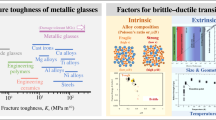Abstract
In this paper we show that metallic glass ribbons obey the laws of plane stress fracture very well. The centre crack tensile specimen was used to investigate the subcritical crack extension prior to catastrophic failure on two alloys. The resulting R-curves are used to reconstruct the experimentally observed variation of the critical stress intensity factor,K c, with initial crack length. Taking into account only the measured subcritical crack extension (up to 50μm) a good qualitative correlation is obtained. Starting from that experimental observation and using very simple assumptions about the variation of the shape of the R-curve as the material embrittles, we propose a schematic description of howK c may vary when the ribbons are annealed and if short or large initial crack lengths are used. An experimental verification is made on one of the alloys.
Similar content being viewed by others
References
D. S. Dugdale,J. Mech. Phys. Solids 8 (1960) 100.
B. A. Bilby, A. H. Cottrell andK. H. Swinden,Proc. R. Soc. A272 (1963) 304.
Y. Waku andT. Masumoto, Proceedings of the 4th International Conference on Rapidly Quenched Metals, Sendai 1981, pp. 1395–8.
S. Kobayashi andS. M. Ohr,ibid. pp. 1353–6.
W. F. Brown andJ. E. Strawley, ASTM SIP 381, (American Society for Testing and Materials, Philadelphia 1964).
K. H. Schwalbe, “Bruchmechanik metallischer Werkstoffe”, edited byC. Hanser (München, 1980).
Recommended practice ASTM E561 76T, ASTM-STP-632 American Society for Testing and Materials, Philadelphia 1977) pp. 241–59.
W. Henning, F. Osterstock, B. L. Nordike, Annual Meeting of DGM (German Society of Metallurgy), Erlangen, May 1983.
J. R. Dixon andJ. S. Strannigan, “Fracture 1969”, Plenum Press, (Brighton, England, 1966) pp. 105–18.
C. N. Freed, A. M. Sullivan andJ. Stoop, ASTM STP 514 (American Society for Testing and Materials, Philadelphia, 1972) pp. 98–113.
S. Henderson, J. V. Wood andG. W. Weidmann,J. Mater. Sci. Lett. 2 373 (1983).
W. Henning, Diplomarbeit, June 1983, Technishce Universität Calusthal, Clausthal-Zellerfeld, West Germany (1983).
M. Calvo, DBA, October 1983, University of Caen, France.
G. Hunger, PhD thesis, Technische Universität Clausthal, Clausthal-Zellerfeld, West Germany (1983).
L. A. Davies,J. Mater. Sci. 10 (1975) 1557.
S. H. Whang, D. E. Polk andB. C. Giessen, Proceedings of the 4th International Conference on Rapdily Quenched Metals, Sendai 1981, pp. 1365–7.
M. Isida,Eng. Fract. Mech. 7 (1975) 505.
H. W. Bergmann, Habilitationsschrift, 1983, Technische Universität Clausthal, Clausthal-Zellerfeld, FRG.
Author information
Authors and Affiliations
Rights and permissions
About this article
Cite this article
Henning, W., Calvo, M. & Osterstock, F. R-curve behaviour of metallic glass ribbons. J Mater Sci 20, 1889–1900 (1985). https://doi.org/10.1007/BF00555298
Received:
Accepted:
Issue Date:
DOI: https://doi.org/10.1007/BF00555298




